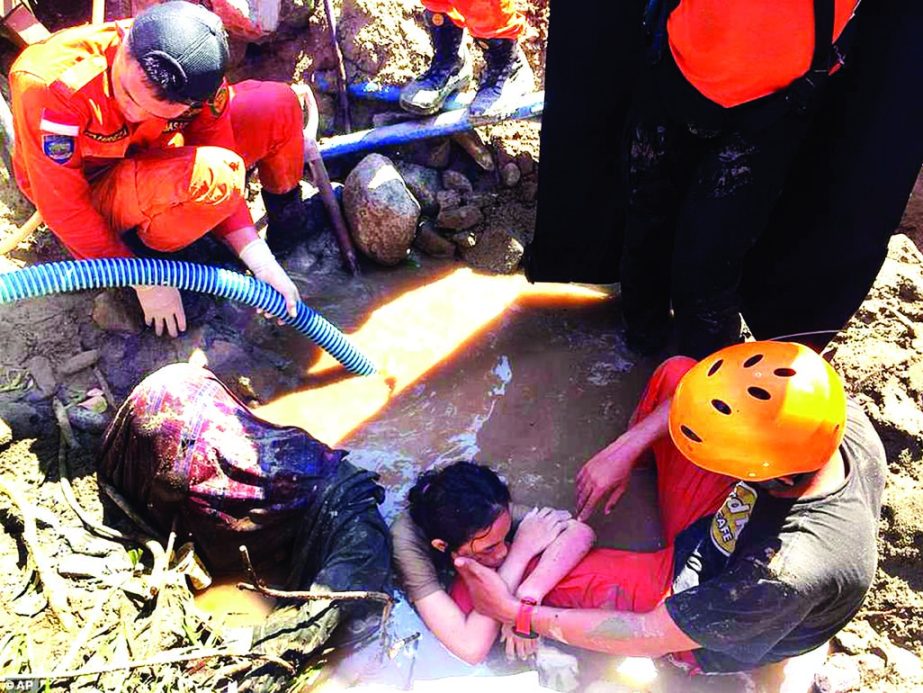
PALU, Indonesia (Reuters) :
The toll from an earthquake and tsunami in Indonesia soared on Sunday to 832 confirmed dead, with authorities fearing it will only climb as rescuers struggle to reach outlying communities cut off from communications and help.
Dozens of people were reported to be trapped in the rubble of two hotels and a mall in the city of Palu, which was hit by waves as high as six meters (20 feet) following the 7.5 magnitude earthquake on Friday. A young woman was pulled alive from the rubble of the city’s Roa Roa Hotel, where up to 60 people were believed trapped. Hundreds of people gathered at the wrecked mall searching for loved ones. With most of the confirmed deaths from Palu, authorities are bracing for much worse as reports filter in from outlying areas, in particular, Donggala, a region of 300,000 people north of Palu and closer to the epicenter of the quake, and two other districts. Vice President Jusuf Kalla said the toll could rise into the thousands. President Joko Widodo visited a housing complex flattened when the quake liquefied the soil it stood on, and called for patience. “I know there are many problems that need to be solved in a short time, including communications,” he said. The ruins would be rebuilt, he said, as aftershocks rattled the region 48 hours after the quake. Scores of residents shouted “we’re hungry, we need food” as soldiers distributed rations from a truck in one neighborhood, while elsewhere television showed pictures of people making off with clothes and other items from a wrecked mall. Internal affairs minister Tjahjo Kumolo, asked about reports of sporadic looting, said he had ordered authorities to help people get food and drink and businesses would be compensated. National disaster mitigation agency spokesman Sutopo Purwo Nugroho told a news conference the affected area was bigger than initially thought, though rescuers only had good access to one of four affected districts – Palu. “We haven’t received reports from the three other areas. Communication is still down, power is still out. We don’t know for sure what is the impact,” he said. “There are many areas where the search and rescue teams haven’t been able to reach,” Nugroho said, adding that teams needed heavy equipment to move broken concrete. Five foreigners – three French, one South Korean and one Malaysian – were among the missing, he said. The 832 fatalities included people crushed in collapsing buildings and swept to their death by tsunami waves. About 16,000 displaced people needed clean water, Nugroho said, while 540 were injured, many getting treatment in tents. Donggala town has been extensively damaged, with houses swept into the sea and bodies trapped in debris, according to a Metro TV reporter on the scene. The Red Cross said it had heard nothing from the region. “This is extremely worrying,” it said in a statement. Finance Minister Sri Mulyani Indrawati said the government had allocated 560 billion rupiah ($37.58 million) for disaster recovery, media reported. Indonesia, which sits on the seismically active Pacific Ring of Fire, is all too familiar with deadly earthquakes and tsunamis. In 2004, a quake off Sumatra island triggered a tsunami across the Indian Ocean, killing 226,000 people in 13 countries, including more than 120,000 in Indonesia. Questions are sure to be asked why warning systems set up around the country after that disaster appear to have failed on Friday. The meteorological and geophysics agency BMKG issued a tsunami warning after the quake but lifted it 34 minutes later, drawing criticism it had been too hasty. But officials said they estimated the waves had hit while the warning was in force. Hundreds of people had gathered for a festival on Palu’s beach when the water surged ashore. A disaster official said the tsunami traveled across the sea at speeds of 800 kph (500 mph) before striking the shore. Video footage on social media showed water and whirls of debris rushing in as people scattered.

